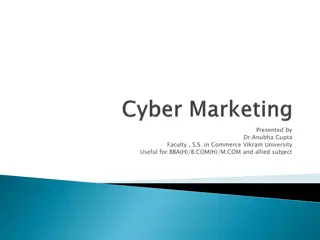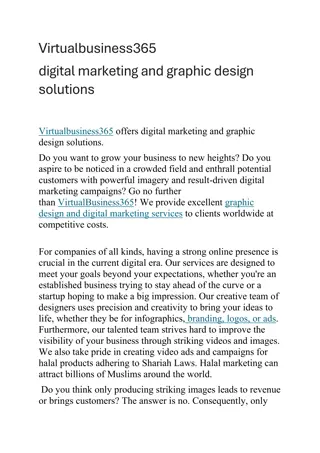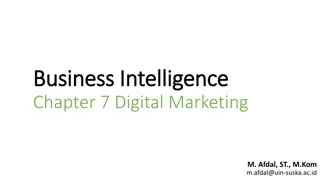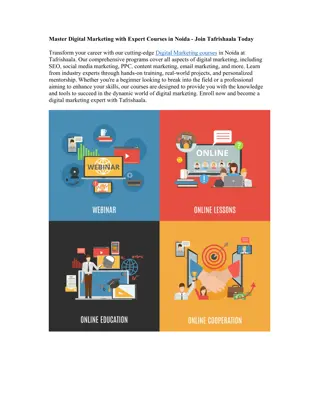Evolution of Services Marketing in the Modern Economy
The shift towards a service economy has transformed marketing practices, leading to the emergence of Services Marketing as a distinct discipline. This evolution highlights the unique characteristics of services, such as intangibility and simultaneous production-consumption. The 1980s mark a pivotal period when services gained recognition for their contribution to the economy, prompting a reevaluation of service marketing strategies. Today, Services Marketing plays a crucial role in the increasingly service-oriented global economy.
Uploaded on Sep 20, 2024 | 2 Views
Download Presentation

Please find below an Image/Link to download the presentation.
The content on the website is provided AS IS for your information and personal use only. It may not be sold, licensed, or shared on other websites without obtaining consent from the author.If you encounter any issues during the download, it is possible that the publisher has removed the file from their server.
You are allowed to download the files provided on this website for personal or commercial use, subject to the condition that they are used lawfully. All files are the property of their respective owners.
The content on the website is provided AS IS for your information and personal use only. It may not be sold, licensed, or shared on other websites without obtaining consent from the author.
E N D
Presentation Transcript
Services Marketing Introduction The world economy nowadays is increasingly characterized as a service economy. This is primarily due to the increasing importance and share of the service sector in the economies of most developed and developing countries. In fact, the growth of the service sector has long been considered as indicative of a country s economic progress. Economic history tells us that all developing nations have invariably experienced a shift from agriculture to industry and then to the service sector as the main stay of the economy. This shift has also brought about a change in the definition of goods and services themselves. No longer are goods considered separate from services. Rather, services now increasingly represent an integral part of the product and this interconnectedness of goods and services is represented on a goods-services continuum.
Definition Services Marketing refers to the marketing of services as against tangible products. services are inherently intangible, are consumed simultaneously at the time of their production, cannot be stored, saved or resold once they have been used and service offerings are unique and cannot be exactly repeated even by the same service provider. Marketing of services is a relatively new phenomenon in the domain of marketing, having gained in importance as a discipline only towards the end of the 20th century. Services marketing first came to the fore in the 1980 s when the debate started on whether marketing of services was significantly different from that of products so as to be classified as a separate discipline. Prior to this, services were considered just an aid to the production and marketing of goods and hence were not deemed as having separate relevance of their own.
The 1980s however saw a shift in this thinking. As the service sector started to grow in importance and emerged as a significant employer and contributor to the GDP, academics and marketing practitioners began to look at the marketing of services in a new light. Empirical research was conducted which brought to light the specific distinguishing characteristics of services. By the mid 1990 s, Services Marketing was firmly entrenched as a significant sub discipline of marketing with its own empirical research and data and growing significance in the increasingly service sector dominated economies of the new millennium. New areas of study opened up in the field and were the subject of extensive empirical research giving rise to concepts such as - the product-service spectrum, relationship marketing, franchising of services, customer retention etc. Prior to this, services were considered just an aid to the production and marketing of goods and hence were not deemed as having separate relevance of their own.
Characteristics of a service are: Intangibility: Services are intangible and do not have a physical existence. Hence services cannot be touched, held, tasted or smelt. This is most defining feature of a service and that which primarily differentiates it from a product. Also, it poses a unique challenge to those engaged in marketing a service as they need to attach tangible attributes to an otherwise intangible offering. Heterogeneity/Variability: Given the very nature of services, each service offering is unique and cannot be exactly repeated even by the same service provider. While products can be mass produced and be homogenous the same is not true of services. eg: All burgers of a particular flavor at McDonalds are almost identical. However, the same is not true of the service rendered by the same counter staff consecutively to two customers. Perishability: Services cannot be stored, saved, returned or resold once they have been used. Once rendered to a customer the service is completely consumed and cannot be delivered to another customer. eg: A customer dissatisfied with the services of a barber cannot return the service of the haircut that was rendered to him. At the most he may decide not to visit that particular barber in the future. Inseparability/Simultaneity of production and consumption: This refers to the fact that services are generated and consumed within the same time frame. Eg: a haircut is delivered to and consumed by a customer simultaneously unlike, say, a takeaway burger which the customer may consume even after a few hours of purchase. Moreover, it is very difficult to separate a service from the service provider. Eg: the barber is necessarily a part of the service of a haircut that he is delivering to his customer.
Types of Services 1.Core Services: A service that is the primary purpose of the transaction. Eg: a haircut or the services of lawyer or teacher. 2.Supplementary Services: Services that are rendered as a corollary to the sale of a tangible product. Eg: Home delivery options offered by restaurants above a minimum bill value.
Difference between Goods and Services : Goods Services A physical commodity A process or activity Tangible Intangible Homogenous Heterogeneous Production and distribution are separation from their consumption Production, distribution and consumption are simultaneous processes Can be stored Cannot be stored Transfer of ownership is possible Transfer of ownership is not possible
Importance of Marketing of Services 1.A key differentiator: Due to the increasing homogeneity in product offerings, the attendant services provided are emerging as a key differentiator in the mind of the consumers. Eg: In case of two fast food chains serving a similar product (Pizza Hut and Domino s), more than the product it is the service quality that distinguishes the two brands from each other. Hence, marketers can leverage on the service offering to differentiate themselves from the competition and attract consumers. 2.Importance of relationships: Relationships are a key factor when it comes to the marketing of services. Since the product is intangible, a large part of the customers buying decision will depend on the degree to which he trusts the seller. Hence, the need to listen to the needs of the customer and fulfill them through the appropriate service offering and build a long lasting relationship which would lead to repeat sales and positive word of mouth. 3.Customer Retention: Given today s highly competitive scenario where multiple providers are vying for a limited pool of customers, retaining customers is even more important than attracting new ones. Since services are usually generated and consumed at the same time, they actually involve the customer in service delivery process by taking into consideration his requirements and feedback. Thus they offer greater scope for customization according to customer requirements thus offering increased satisfaction leading to higher customer retention.
The 7 Ps of Services Marketing The first four elements in the services marketing mix are the same as those in the traditional marketing mix. However, given the unique nature of services, the implications of these are slightly different in case of services. Product: In case of services, the product is intangible, heterogeneous and perishable. Moreover, its production and consumption are inseparable. Hence, there is scope for customizing the offering as per customer requirements and the actual customer encounter therefore assumes particular significance. However, too much customization would compromise the standard delivery of the service and adversely affect its quality. Hence particular care has to be taken in designing the service offering.
Pricing: Pricing of services is tougher than pricing of goods. While the latter can be priced easily by taking into account the raw material costs, in case of services attendant costs - such as labor and overhead costs - also need to be factored in. Thus a restaurant not only has to charge for the cost of the food served but also has to calculate a price for the ambience provided. The final price for the service is then arrived at by including a mark up for an adequate profit margin. Place: Since service delivery is concurrent with its production and cannot be stored or transported, the location of the service product assumes importance. Service providers have to give special thought to where the service would be provided. Thus, a fine dine restaurant is better located in a busy, upscale market as against on the outskirts of a city. Similarly, a holiday resort is better situated in the countryside away from the rush and noise of a city.
Promotion: Since a service offering can be easily replicated promotion becomes crucial in differentiating a service offering in the mind of the consumer. Thus, service providers offering identical services such as airlines or banks and insurance companies invest heavily in advertising their services. This is crucial in attracting customers in a segment where the services providers have nearly identical offerings. People: People are a defining factor in a service delivery process, since a service is inseparable from the person providing it. Thus, a restaurant is known as much for its food as for the service provided by its staff. The same is true of banks and department stores. Consequently, customer service training for staff has become a top priority for many organizations today.
Process: The process of service delivery is crucial since it ensures that the same standard of service is repeatedly delivered to the customers. Therefore, most companies have a service blue print which provides the details of the service delivery process, often going down to even defining the service script and the greeting phrases to be used by the service staff. Physical Evidence: Since services are intangible in nature most service providers strive to incorporate certain tangible elements into their offering to enhance customer experience. Thus, there are hair salons that have well designed waiting areas often with magazines and plush sofas for patrons to read and relax while they await their turn. Similarly, restaurants invest heavily in their interior design and decorations to offer a tangible and unique experience to their guests.























